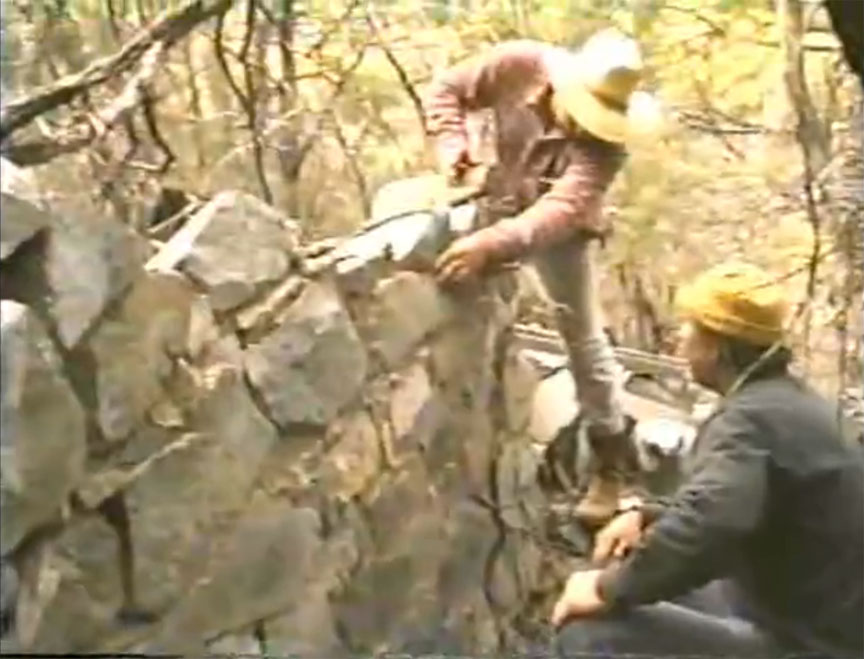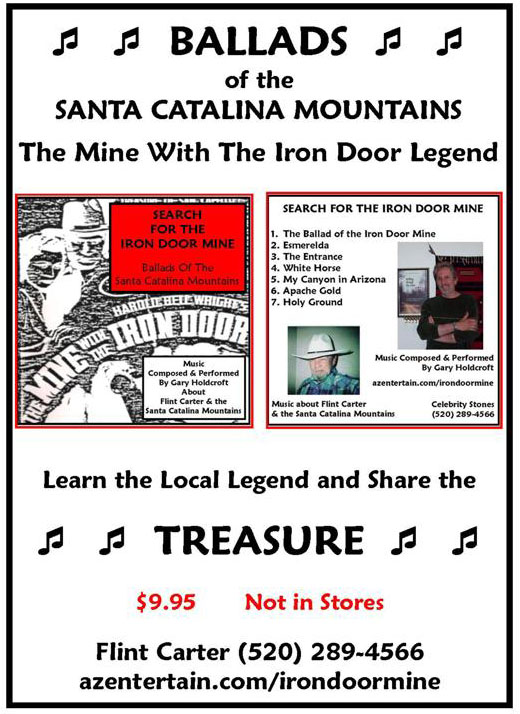Entertainment Magazine: Tucson: The Lost City The Lost City of the Santa Catalina Mountains– The Nine Mile City– is found!
Video: Flint Carter explores the Lost City of the Santa Catalina Mountains - from the original video recorded in 1985. Read more about Flint Carter's experiences in "Canyon of Gold." Just north of Tucson, Arizona hidden deep within an extremely remote area of the majestic Santa Catalina Mountains, and the inner sanctum of the Cañada del Oro, are ruins that may be linked to the legends of the Mine with the Iron Door and the fabled Lost City of the Santa Catalinas.
Photo: Local prospector Flint Carter and friend examines the walls of a structure found near Mt. Lemmon, close to Summerhaven in the 1980s. This is the possible site of the Lost City of the Catalinas, according to Carter who has been mining the Catalinas for more than four decades. The remains of nearly a half dozen stone constructed buildings are scattered in an area that is suspected to be connected with the famous legend of the Iron Door Mine. At this remote location there is evidence of both human habitation and mining production–scattered stone ruins, some artifacts, mineshafts, and debris. Abandoned mining shafts, tunnels and early human activity has been documented. In 1978 Tommy Thompson, president of the Oracle Historical Society, along with film producer Thomas Perry, prospector William “Flint” Carter, and six others drove to Catalina Camp west of Oracle Ridge. They proceeded on foot to the Reef of Rock in search of the legendary Lost City. They found evidence of old stoves, possibly from the 1880s, but not the fabled Lost City (Thomas Perry, an actor, played the holy man in the film The Trial of Billy Jack. He later produced Wanda Nevada, (1979), a story of a gold mine in the Grand Canyon starring Brooke Shields and Peter Fonda). The Lost City site was finally discovered when Carter, with another group, found the ruins near Catalina Camp in 1985. They didn’t think it was much because they only found a few old stone foundations and walls. It was anti-climatic. But, it seemed someone was there earlier with a bulldozer, pushed material over the hill, and destroyed any other evidence of the city. Nearby was an old mining tunnel. Carter staked a claim and got a permit to open the tunnel. But after four years of extensive digging, it turned out to be just a 30-foot exploratory tunnel from the turn of the century. Drill holes were found at the end of the tunnel. Several additional quests were conducted over the years with varying results. During another expedition in 1995, one of the members of Carter’s group included George Mroczkowski, author of the “Professional Treasure Hunter,” found an 1812 Mexican coin in front of a caved-in tunnel. Carter staked a claim and got a permit to open the tunnel. But after four years of extensive digging, it turned out to be just a 30-foot exploratory tunnel from the turn of the century. Drill holes were found at the end of the tunnel. Several additional quests were conducted over the years with varying results. A recent expedition in the spring of 2014 with a geologist and crew revealed additional structures and evidence not observed earlier. A recent expedition in the spring of 2014 with a geologist and crew revealed additional structures and evidence not observed earlier. Spanish mining interests fueled legendsThe legend that is tied to the Lost City, and the nearby mines involves the Spanish missionaries back in the early 1700s. According to these stories passed down from generation to generation, the Spanish forced the local natives to work the gold mines until the expulsion of the Jesuit missionaries in 1767. The location of the mine and community became lost. Also called the Nine Mile City of The Santa Catarinas ("Nueva Mia Ciudad"), this site was reportedly rediscovered by two men in an article published in the "Arizona Weekly Star" Tucson newspaper on March 4, 1880. The prospectors said they came to the area "on January 10, 1880 for the express purpose of exploring the mountains for the NuevaMia Ciudad and the mine with the iron door." Actually, milla is Spanish for mile. The newspaper article described their journey into the Cañada del Oro in search of the mysterious ruins and lost gold mine of the Spaniards.
An article in the February 17, 1891 edition of the "Tombstone Prospector" reported a recent "New Discovery." It was one of the earliest mentions of a lost city and a mine with an iron door.
21st Century Expedition to the Lost CityA film documentary is planned with more details of the remnants left behind. The Lost City/Lost Mine expedition is headed by Flint Carter who rediscovered the ruins and lost mine in the 1980s and his continued visits to the site. Carter has held several mining claims in the area for more than forty years. Carter hopes to establish a link between these structures and the first building of one of the San Xavier Mission stone houses for the missionaries. Carter also wants to compare the structures to a building at the edge of the Catalinas that once served as a stage depot and possible mission in earlier times. Next:
|

 "Ballads of the Santa Catalina Mountains" CD
"Ballads of the Santa Catalina Mountains" CD Flint
Carter, a Tucson, Arizona miner, has samples of "Cody Stone" mined in
the Santa Catalina Mountains of Southern Arizona. This stone is
jewelry grade silver and quartz ore, and weighs 8 pounds or more. It
also contains scheelite and fluoresces. Valued at $5 a carat. This
particular piece is the second largest specimen recovered. Extremely
rare. There is a 40 page provenance of the object, including an
assay by the University of Arizona and opinions from the
Gem Institute of America and other sources. More samples of
Flint
Carter, a Tucson, Arizona miner, has samples of "Cody Stone" mined in
the Santa Catalina Mountains of Southern Arizona. This stone is
jewelry grade silver and quartz ore, and weighs 8 pounds or more. It
also contains scheelite and fluoresces. Valued at $5 a carat. This
particular piece is the second largest specimen recovered. Extremely
rare. There is a 40 page provenance of the object, including an
assay by the University of Arizona and opinions from the
Gem Institute of America and other sources. More samples of